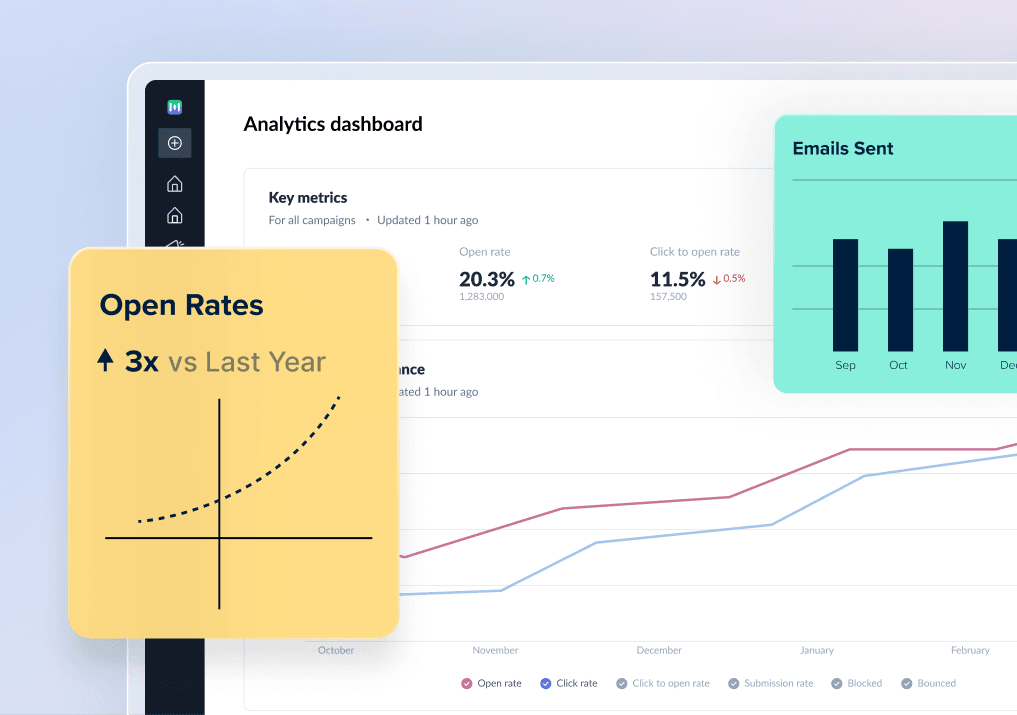Creating visually appealing and well-structured emails is vital. One of the key elements in crafting effective email campaigns is mastering the art of HTML email tables. The tables not only enhance the aesthetic appeal of your emails but also play a crucial role in organizing the content of your email and making the information easily digestible for your readers.
From understanding the basic structure of HTML tables to implementing responsive designs that adapt to various devices, we will cover essential techniques in this guide that can elevate your email marketing game.
Table of Contents
- What is an HTML email table?
- Common uses of HTML email tables
- Why use HTML to create email tables?
- How to create HTML email tables?
- 7 Best Practices for Creating HTML Email Tables
- Limitations of HTML email table
- An effective alternative to creating email tables using HTML
- Takeaways
What is an HTML email table?
An HTML email table refers to a table embedded in emails that are coded using HTML when designing an HTML email to structure the email's layout. Unlike traditional web design, where tables have become obsolete in favor of CSS for layout purposes, tables are widely used in HTML emails due to their compatibility with various email clients.
In HTML email design, tables are uniquely valuable due to their consistent rendering across various email clients. In contrast with modern web design, where CSS is preferred for layouts, email clients often struggle with CSS, making tables the preferred choice for structuring emails. Email templates created with HTML tables are visually appealing and organized.
Common uses of HTML email tables
HTML tables are versatile and can be used for various purposes. Here are the common uses of HTML tables:
Data tables are fundamental for representing information in a structured format. These tables display raw data, such as financial information, statistics, or organized data.
Comparison Tables: Comparison tables are helpful when comparing multiple items or entities side by side. They are often used in product comparisons, feature lists, or pricing comparisons on websites.
Forms: Tables can be used within HTML forms to structure form elements. Each row can represent a form field and its label, providing a neat arrangement for user input.
Why use HTML to create email tables?
Tables in HTML emails are used for organizing content in a structured format. Here's why they are employed:
- Tables offer precise control over the layout of content in emails, ensuring elements like text, images, and links are arranged in a visually appealing manner.
- They are widely supported by email clients, making them a reliable choice for consistent rendering across various devices and platforms.
- With proper coding, HTML tables in emails can be made responsive, adapting their layout for different screen sizes, ensuring a seamless user experience on both desktop and mobile devices.
In email marketing, HTML email tables offer several key benefits:
HTML email tables ensure consistent formatting across various email clients and devices. Tables provide a structured layout, preserving the intended design regardless of the recipient's email service provider.
Tables enable responsive email design, allowing marketers to create mobile-friendly layouts. By structuring content within tables, emails adapt to different screen sizes, providing optimal user experience on desktop and mobile devices.
3.Tables allow marketers to organize content neatly, making it easier for recipients to scan and comprehend the email's message. Information can be segmented into rows and columns, enhancing readability.
- HTML email tables allow for the precise placement of images, text, and other elements, enhancing the visual appeal of your emails.
How to create HTML email tables?
You can utilize the different tags to create HTML tables. Let’s take a look at this step-by-step guide to learn more about this:
- Use the table tag to define your table.
- Inside the table,use the tr tag to define table rows.
<table>
<tr></tr>
<tr></tr>
</table>
- Within the tr, use the td tag for table data cells.
- Inside tr, use the td tag for table data cells.
<table>
<tr>
<th>Header 1</th>
<th>Header 2</th>
</tr>
<tr>
<td>Row 1, Cell 1</td>
<td>Row 1, Cell 2</td>
</tr>
<tr>
<td>Row 2, Cell 1</td>
<td>Row 2, Cell 2</td>
</tr>
</table>
You can use advanced table design in html through:
5.Utilizing span rows or columns using the rowspan and colspan attributes to merge cells horizontally and vertically for intricate layouts.
<td rowspan="2">Span 2 Rows</td>
<td colspan="2">Span 2 Columns</td>
6.Also, you can nest tables within tables to create complex structures.
7.Use CSS or the border attribute within the table tag to add borders.
Remember to adjust the number of columns and rows according to your needs. Tables can be further styled and customized using CSS for a polished appearance.
7 Best Practices for Creating HTML Email Tables
When testing and troubleshooting email tables across various email clients and devices using HTML, it's essential to follow these best practices:
- Use inline CSS to apply styles directly, which ensures consistent rendering across different email platforms and webmail services.
- Don’t link to external CSS files . Some email clients may block external stylesheets, leading to inconsistent formatting.
- Try to keep your tables simple, as complex nesting causes rendering issues across different clients.
- Define explicit widths for your tables and cells in pixels . This prevents the table from stretching unexpectedly, especially on mobile devices.
- Use background colors sparingly , as some email clients might not support background colors or might render them differently.
- Extensively test your HTML email across various email clients, devices, and screen sizes. Use email testing tools to ensure your table renders correctly everywhere.
- Use HTML attributes wisely and stick to well-supported HTML attributes and elements.Avoid using JavaScript or complex interactivity within tables, as these might not function as intended in many email clients.
Limitations of HTML email table
HTML email tables are widely used for structuring emails, but they come with limitations:
Email clients have varying support for CSS styles, making it challenging to achieve consistent table formatting across different platforms.
Some email clients might not render tables correctly, leading to distorted layouts or broken designs.
Tables in HTML emails have limited interactive capabilities compared to web-based applications.
Creating responsive email tables that adapt well to different screen sizes is challenging due to inconsistent CSS support in various email clients.
An effective alternative to creating email tables using HTML
Creating HTML email tables can be challenging and not everyone enjoys coding. Hence, Email Service Providers (ESPs) offer easy solutions that allow users to create tables visually without writing any code.
Mailmodo is an ESP that focuses on bringing interactivity to emails while offering several features that simplify setting up email tables. In addition to providing an intuitive drag-and-drop interface, it also allows users to create email templates with tables easily. Table elements can be dragged onto the template to structure easily and design tables within emails.
Users can customize these templates according to their needs, adjusting table layouts, colors, and fonts to match their branding. There exists support for dynamic content integration within tables. Marketers can personalize table data based on recipient attributes, creating highly targeted and relevant content for each recipient.
Takeaways
Creating well-structured HTML email tables involves a combination of coding proficiency and creativity. Marketers must consider table layout, column widths, cell padding, and responsive design to ensure emails are displayed correctly on different screens. Moreover, optimizing email tables for mobile devices is essential.
HTML email tables play a significant role in structuring emails, organizing content, and enhancing user experience. Using HTML and CSS techniques, marketers can design visually appealing and responsive email tables that adapt seamlessly to various devices and make your emails more appealing and engaging to your readers, resulting in more effective email marketing campaigns.
What you should do next
Hey there, thanks for reading till the end. Here are 3 ways we can help you grow your business:
Talk to an email expert. Need someone to take your email marketing to the next level? Mailmodo’s experts are here for you. Schedule a 30-minute email consultation. Don’t worry, it’s on the house. Book a meet here.
Send emails that bring higher conversions. Mailmodo is an ESP that helps you to create and send app-like interactive emails with forms, carts, calendars, games, and other widgets for higher conversions. Get started for free.
Check out our AI prompts library. If you need AI prompts for ChatGPT or Bing, here's a ready-made database we’ve built to help marketers succeed at prompt engineering. Get your AI prompts here.
Get smarter with our email resources. Explore all our knowledge base here and learn about email marketing, marketing strategies, best practices, growth hacks, case studies, templates, and more. Access guides here.






